Thank you for visiting! By the way… any links on this page that lead to products on Amazon and other stores/partners are affiliate links Aquarium Store Depot earns a commission if you make a purchase.
Looking to add an unusual color to your tropical fish tank? The bright orangey-red cherry barb is an often overlooked species that is great for most community tank setups. These fish are moderately active and grow to a couple of inches in length. They demonstrate schooling behaviors that pop out against a deep green backdrop of live plants.
These peaceful fish should get along with everyone, but some fish aren’t good choices. Let’s go over the best cherry barb tank mates to add to your fish tank!
Key Takeaways
- Cherry barbs are peaceful schooling fish that need a densely planted tank.
- These fish are relatively hardy and can be kept in a wide range of aquarium conditions.
- Compatible tank mates include other schooling fish as well as several larger feature species.
- Cherry barbs have the potential to become slightly aggressive towards each other and smaller, slower species.
Introduction
Cherry barbs have become increasingly popular over the past several years and for good reason. Before these small, colorful fish became mainstream, the term ‘barb’ generally referred to tiger barbs (Puntius tetrazona). As many hobbyists quickly found out, tiger barbs are aggressive fish that aren’t the best choice for a community tank. Because of this negative connotation, many hobbyists still relate the barb term to aggression.
The fact of the matter is that cherry barbs are some of the most community-friendly fish available for freshwater aquariums. Cherry barbs (Puntius titteya) are in the same scientific genus as their aggressive cousins but replace overaggression with intense coloration.
Appearance
The cherry barb is named after its bright orange coloration. Some individuals may have a noticeable dark red line from the tip of their face to the dorsal fin.
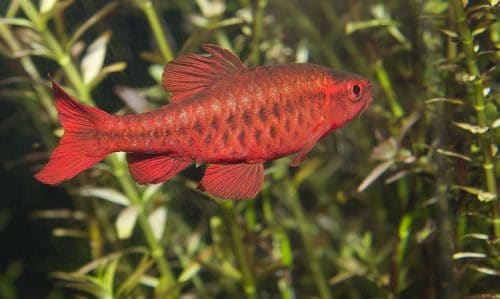
Cherry barbs grow to be about 2 to 3 inches long and have a torpedo-shaped body. Though this body shape allows them to quickly dart through the water column if threatened by a predator, cherry barbs are generally very relaxed and controlled swimmers; they are slightly more active than small species of tetra but demonstrate the same jagged movements.
Male cherry barbs are smaller in size and more torpedo-shaped than female fish. Female cherry barbs are much plumper and have less intense coloration that is usually more brown than red or orange.
Tank Requirements
Cherry barbs aren’t necessarily difficult fish to keep, but some responsibility comes with having them in your freshwater aquarium. Unfortunately, cherry barbs are only endemic to small flooded regions throughout the country of Sri Lanka and are now considered a vulnerable species1. This is due to deforestation and the destruction of their native rivers and floodplains.
To have these fish thrive in your own aquarium, they should be kept in conditions similar to those found in their natural habitat. Luckily, cherry barb fish have been successfully bred in the aquarium trade so most individuals are not wild-caught.
But are cherry barbs easy to keep in the aquarium?
Cherry barbs are relatively easy to keep in standard freshwater tanks. There are a few special considerations needed when setting up their aquarium and keeping them with other species. This mostly includes matching their natural habitat as best as possible while ensuring they don’t outcompete other species for food during feeding times. Otherwise, their needs are very similar to those of any other tropical fish.
Here’s how to set up the best fish tank for cherry barbs!
Tank Setup
Like many other tropical fish, the cherry barb is a schooling fish that needs to be kept in groups of at least six or more. As a result, this increases the minimum tank size recommended to about 30 gallons for comfortably keeping a school. That being said, many hobbyists have kept a school of cherry barb fish in a 20 gallon long tank, though this is only recommended if the overall tank stocking is very light.
A classic 20 gallon aquarium in its 30 inch long variant. A very popular aquarium.
Otherwise, these freshwater fish can be kept with a variety of species as long as tank conditions are catered around them. Cherry barbs come from waters filled with dense vegetation and life that protects them from the strong overhead sun. In the aquarium, these conditions should be met by having a well-planted tank with plenty of plants that cover the surface of the water, like floating species. A gravel or sand substrate may be based on preference but should facilitate healthy root growth.
Cherry barbs are not messy fish and do not require a ton of filtration. Allowing the tank to be messier than average can be extremely beneficial for heavily planted tanks that need constant nutrient input. Filtration should offer a low to medium water current and keep water quality stable between water changes.
Water Parameters
Cherry barbs aren’t one of the most hardy fish available in the aquarium hobby but captive-bred individuals can withstand most water parameters as long as they don’t fluctuate. That being said, the ideal water quality parameters for a cherry barb tank are:
Cherry barbs are tropical fish and need a constant water temperature between 74-82° F.
What Do You Feed Them?
Cherry barb fish are omnivores and will readily eat anything that can fit inside their mouths. This includes various tiny insects and plant matter they might find floating in the water.
In the aquarium, they can be given high-quality flake foods and pellets that sink to the middle of the water column. They especially like an occasional treat of brine shrimp, bloodworms, and daphnia.
Will They Breed in a Community Tank?
In the right home aquarium, cherry barbs will breed when they feel ready. This barb species is an egg layer that can be spawned in the display aquarium or a separate tank. As males and females are easy to differentiate, it’s recommended to keep a single male with a small group of females.
When ready, the female will lay her eggs and the male will fertilize them. At this point, both the male and female cherry barbs should be removed.
How many cherry barbs should you keep together?
The cherry barb is a schooling species and should be kept in groups of at least six or more at all times. Male cherry barbs can become aggressive towards each other so only one male should be kept for every small group of females. For a larger tank, multiple males may be kept as long as there is room to disperse the aggression.
Are they aggressive?
Cherry barbs are not very aggressive, but they are still a barb species. This means that there may be some intraspecies aggression, particularly between males during spawning periods. Large cherry barb individuals may also start to nip at smaller, less active species.
The Best Cherry Barb Tank Mates
While a school of cherry barb fish can easily fill a planted tank on their own, many hobbyists like to keep these bright fish with other species. Luckily, they are one of the best community-friendly species available as they are colorful and present in the aquarium.
All this considered, here are some of the best cherry barb tank mates available for a community tank setup.
1. Zebra Danio
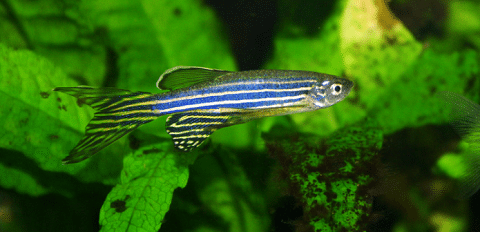
- Scientific Name: Danio rerio
- Adult Size: 3 inches
- Care Level: Easy
- Temperament: Peaceful
- Swimming Level: Top and middle
- Minimum Tank Size: 10 gallons
- pH: 6.5-7.5
- Water Temperature: 64-75° F
Zebra danios are one of the most popular freshwater fish available in the aquarium trade. These are peaceful yet active fish that can bring life to the upper portions of the aquarium.
Zebra danios can be a great cherry barb tank mate, especially in aquariums with a lower average water temperature. However, the activity level of the zebra danio should be considered. Most times, their activity will cause cherry barbs to also become bold in character. But sometimes, this activity can be too much and cause you cherry barbs to become timid and reclusive.
If you find that your cherry barbs turn into timid fish, then you may need to increase their schooling size or remove the zebra danios altogether.
2. Rosy Barbs

- Scientific Name: Puntius conchonius
- Adult Size: 6 inches
- Care Level: Easy
- Temperament: Semi-aggressive
- Swimming Level: All
- Minimum Tank Size: 30 gallons
- pH: 6.0-7.0
- Water Temperature: 64-74° F
Rosy barbs are large fish that can do well with cherry barbs if some specific conditions are met. These fish are labeled as semi-aggressive fish as they can sometimes be fin nippers among themselves and with slower fish. This shouldn’t be a problem for keeping them with cherry barbs as their moderate activity will influence your cherries to be more active.
Rosy barbs are also unique in the fact that they do best in cooler water temperatures. This means that some acclimation may be necessary to get your cherry barbs in the temperatures preferred by your rosy barbs.
3. Guppy Fish
An undemanding fish that is a livebearer. Many varieties available
- Scientific Name: Poecilia reticulata
- Adult Size: 2 inches
- Care Level: Very easy
- Temperament: Peaceful
- Swimming Level: Top
- Minimum Tank Size: 10 gallons
- pH: 5.5-8.0
- Water Temperature: 64-82° F
Guppy fish get a lot of hate due to being the stereotypical beginner species, but this incredibly hardy fish can bring a ton of color and movement to an aquarium.
Though cherry barbs have unique coloration, they can be difficult to match with other tank mates. Guppies come in almost every color imaginable, which can be used to either complement or contrast those of your cherry barbs.
Keep in mind that guppies are prolific livebearers that can quickly overpopulate a small fish tank.
4. Mollies
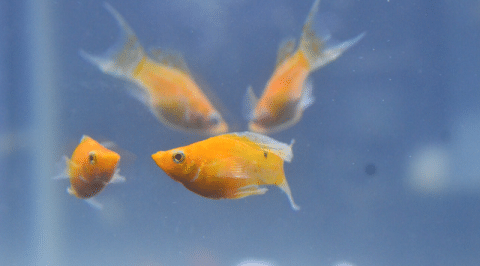
- Scientific Name: Poecilia sphenops
- Adult Size: 3-5 inches
- Care Level: Very easy
- Temperament: Peaceful
- Swimming Level: Top and middle
- Minimum Tank Size: 10 gallons
- pH: 7.0-8.0
- Water Temperature: 72-82° F
Similarly, mollies are also a great, beginner-friendly cherry barb tank mate. Mollies are much larger than guppies and have bigger splashes of color and movement. They can sometimes overpower other fish, especially during feeding times. It may be necessary to feed your mollies and cherries in two different locations of the aquarium.
Like guppies, mollies are livebearers. In addition to their large size and active demeanor, it’s recommended to only keep cherry barbs and mollies together in aquariums with plenty of swimming space.
5. Platy Fish

- Scientific Name: Xiphophorus maculatus
- Adult Size: 2 inches
- Care Level: Easy
- Temperament: Peaceful
- Swimming Level: Top and middle
- Minimum Tank Size: 10 gallons
- pH: 7.0-8.0
- Water Temperature: 64-82° F
If mollies are too much for your aquarium, then platies are just as easy but at half the size. Platy fish come in a variety of bright colors that can be used to compliment those of your cherry barbs. They are still very active fish but are more relaxed than guppies or mollies. That being said, they are also prolific livebearers that can quickly overpopulate an aquarium.
6. Dwarf Gouramis

- Scientific Name: Trichogaster lalia
- Adult Size: 2-3 inches
- Care Level: Moderate
- Temperament: Peaceful to semi-aggressive
- Swimming Level: Top and middle
- Minimum Tank Size: 10 gallons
- pH: 6.0-8.0
- Water Temperature: 72-82° F
The dwarf gourami is a popular freshwater fish that’s often used as a featured species, especially in smaller aquariums. For the most part, dwarf gouramis are great tank mates for a cherry barb tank. However, some dwarf gouramis have been known to be aggressive towards each other and to other fish. If considering a dwarf gourami, it’s strongly recommended to keep larger schools of cherry barb and only one gourami.
7. Neon Tetra
Use Promo Code ASDFLIPPROMO
One of the most popular freshwater community schooling fish available in the aquarium trade. Great neon blue colors!
- Scientific Name: Paracheirodon innesi
- Adult Size: 1-2 inches
- Care Level: Moderate
- Temperament: Peaceful
- Swimming Level: Middle
- Minimum Tank Size: 10 gallons
- pH: 5.0-7.0
- Water Temperature: 68-82° F
Another popular tropical fish, the neon tetra is a moderate-level fish. These fish are relatively delicate when transporting and acclimating and often die within the first few days of having them in the aquarium. Even after they’re established, they are likely to die off one by one.
That being said, if you have success keeping neon tetras, they can be great tank mates for cherry barbs. Of the two, cherry barbs tend to be more aggressive than neons and so there should be more neon tetras than cherry barbs.
8. Cardinal Tetra
A very popular schooling fish. Looks like the Neon Tetra, but with longer blue and red stripes. Grows larger than a neon tetra as well
- Scientific Name: Paracheirodon axelrodi
- Adult Size: 2 inches
- Care Level: Moderate
- Temperament: Peaceful
- Swimming Level: Middle
- Minimum Tank Size: 10 gallons
- pH: 5.0-7.0
- Water Temperature: 68-82° F
Cardinal tetras are almost exact in color and behavior to neon tetras but are slightly larger and a little more sensitive to water parameters. As another type of schooling fish, the number of cardinals should be greater than the number of cherry barbs; the larger size of cardinals helps deter some cherry barb aggression, but greater numbers will help keep them safe from potential nipping.
9. Penguin Tetra

- Scientific Name: Thayeria boehlkei
- Adult Size: 2-3 inches
- Care Level: Easy
- Temperament: Peaceful
- Swimming Level: Middle
- Minimum Tank Size: 30 gallons
- pH: 5.5-8.5
- Water Temperature: 64-82° F
Penguin tetras are very adaptable fish that can be great tank mates for the cherry barb. Penguin tetras are very similar in shape, size, and behavior to the cherry barb. The benefit of keeping penguin tetras is that they bring schooling fish behavior without offering color. This can be useful for hobbyists looking to accent their cherry barbs instead of other species.
10. Rasboras
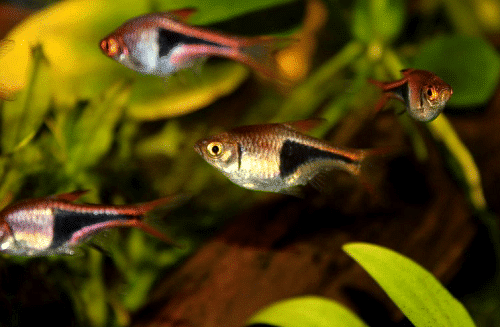
- Scientific Name: Rasbora spp.
- Adult Size: <4 inches
- Care Level: Easy
- Temperament: Peaceful
- Swimming Level: Top and middle
- Minimum Tank Size: 10 gallons
- pH: 6.5-8.0
- Water Temperature: 75-80° F
Many species of Rasbora can be ideal tank mates for cherry barbs. One of the most popular rasboras kept with cherry barb fish is the harlequin rasbora (Trigonostigma heteromorpha). These peaceful fish feature some of the same colors seen on the cherry barb but have a much smaller body and angular patterns.
Each species of Rasbora will be different from the next. Some are more stagnant swimmers, like harlequin rasboras, while others enjoy being just as, if not more, active than cherry barbs. Make sure to research compatibility before placing these fish with each other.
11. Kribensis
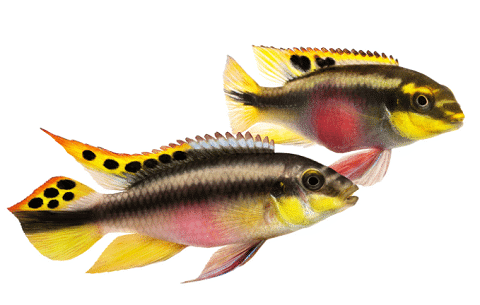
- Scientific Name: Pelvicachromis pulcher
- Adult Size: 4 inches
- Care Level: Easy
- Temperament: Semi-aggressive
- Swimming Level: Middle to bottom
- Minimum Tank Size: 55 gallons
- pH: 6.0-8.0
- Water Temperature: 72-82° F
You might be surprised to find a cichlid on this list of the best tank mates for a cherry barb tank, but kribensis typically don’t mind a schooling fish in their aquarium; in setups like this, aquarium conditions and species should be chosen based on the kribensis.
For the most part, kribensis and cherry barbs will ignore each other in the aquarium. However, kribensis are cichlids that have the potential to breed and become aggressive during spawning periods. This can cause some conflict with the cherry barbs.
If there is serious aggression, the kribensis should be moved to a breeding tank during these times. Additional cherry barbs and aquarium plants may also be added for more protection in numbers and structure.
12. Celestial Pearl Danio
A great-looking danio fish. Males are more colorful than females. A midway dwelling fish
- Scientific Name: Celestichthys margaritatus
- Adult Size: 1 inch
- Care Level: Moderate
- Temperament: Peaceful
- Swimming Level: Middle and bottom
- Minimum Tank Size: 10 gallons
- pH: 6.5-7.5
- Water Temperature: 72-82° F
Many hobbyists that keep cherry barbs are likely to keep celestial pearl danios. For whatever reason, these two fish species are often paired together as being more challenging or unusual fish tank options. In reality, both these hardy fish species are readily available, easy to keep, and even great tank mates with the right setup.
There is a large difference in demeanor between celestial pearl danios and cherry barbs. Cherry barbs eat very quickly and are moderately active in general. Celestial pearl danios take their time and can be reclusive in overstimulating situations.
To help balance this difference, special attention will need to be given during feeding times. Though not likely, there is also a chance that large cherry barbs could eat particularly small celestial pearl danios.
13. Honey Gourami
One of the more peaceful Gourami fish available in the hobby. Has a unique yellow coloration and only grows up to 2 inches in length
- Scientific Name: Trichogaster chuna
- Adult Size: 2 inches
- Care Level: Easy
- Temperament: Peaceful
- Swimming Level: All
- Minimum Tank Size: 10 gallons
- pH: 6.0-7.5
- Water Temperature: 72-82° F
If a dwarf gourami is giving you trouble, then the honey gourami might be a better alternative for your cherry barb tank. Honey gouramis are actually smaller than their dwarf counterparts and much more community tank appropriate.
While not aggressive, the honey gourami can be overly inquisitive. This could potentially stress out smaller cherry barb individuals. In return, large cherry barbs can also stress out a smaller honey gourami.
14. Kuhli Loach
Kuhli Loaches are hardy bottom-dwelling fish. Nocturnal in nature. Gets along with many fish and tolerate of coldwater environments
- Scientific Name: Pangio spp.
- Adult Size: 3-5 inches
- Care Level: Moderate
- Temperament: Peaceful
- Swimming Level: Bottom
- Minimum Tank Size: 20 gallons
- pH: 6.5-7.5
- Water Temperature: 75-86° F
Kuhli loaches are a great choice for a cherry barb tank that needs some life at the bottom of it. These fish prefer warmer tank water temperatures so some acclimation may be needed to get them in the same range as cherry barbs.
Another consideration for keeping these freshwater fish is that they are bottom feeders. Cherry barbs are very active feeders and will quickly eat any food that floats down the water column. It may be necessary to supplement sinking pellets or other heavy foods that float past the barbs and onto the substrate for the loaches to eat.
15. Otocinclus
A small algae-eating fish. Also great with freshwater shrimp.
- Scientific Name: Otocinclus spp.
- Adult Size: <4 inches
- Care Level: Difficult
- Temperament: Peaceful
- Swimming Level: All
- Minimum Tank Size: 20 gallons
- pH: 6.5-7.5
- Water Temperature: 75-82° F
If you’re struggling with an algae problem in your cherry barb aquarium, you may have been recommended Otocinclus, or otos for short. Otos are very efficient algae eaters that can clean a tank overnight. But this is what also makes them so difficult to keep.
Otocinclus are schooling fish that need a constant supply of algae. This limits them to mature tanks that have plenty of natural food available. If this describes your aquarium, then otos are good tank mates for cherry barbs as the two will rarely interact.
Bad Choices
While cherry barbs can get along with most fish species, there are some that they will never be compatible with. This includes overly aggressive or active species such as:
- Aggressive small to medium-sized cichlids, like convict cichlids (Amatitlania nigrofasciata)
- Large African or South American cichlids, like Oscar fish (Astronotus ocellatus)
- Any other fish species that can easily fit a cherry barb in its mouth
Conclusion
The cherry barb is an often overlooked fish that is highly compatible with most other fish species available. A school of cherry barbs can offer intense color and movement in a small or large tank setup with minimal additional work. Some of the best cherry barb tank mates are other schooling species, but they can also be kept with several larger feature species.
- About the Author
- Latest Posts
I’m thrilled that you found Aquarium Store Depot! Here you’ll find information on fish, aquariums, and all things aquatics related. I’m a hobbyist (being doing this since I was 11) and here to help other hobbyists thrive with their aquariums! I adhere to a high quality Editorial Process and Review products with real life field usage and practical analysis.


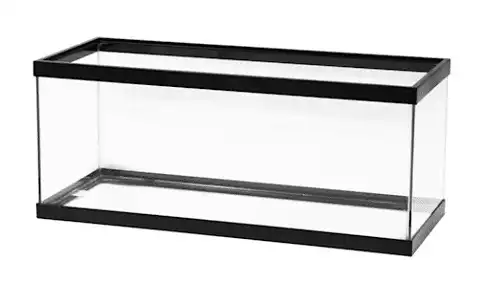
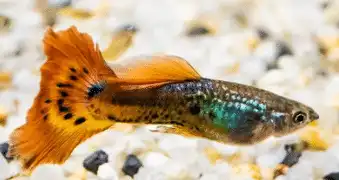
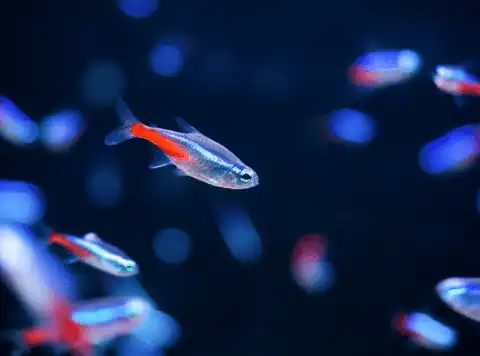
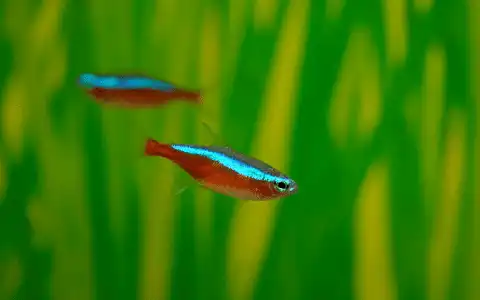
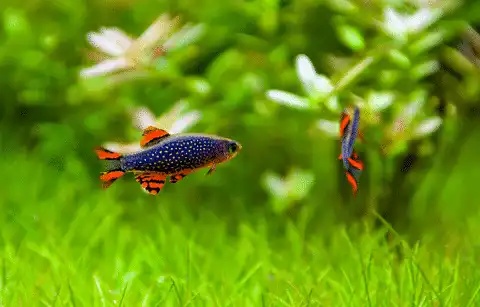


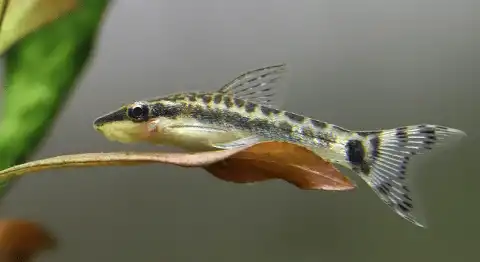




will cherry barb and tiger barb and gold barb and odessa barb and black ruby barb and snakeskin barb all live together in a community tank
Most barbs can mix together in a community tank as long as the aquarium is large enough and the school size is big enough. The bigger the group, the lesser the chance for bullying to occur. You may run into issues with breeding with a mixed group. All fish are different. You’ll need to try them out for yourself and see if it works out. They will fight the most in the bigger while they are establishing their pecking order.